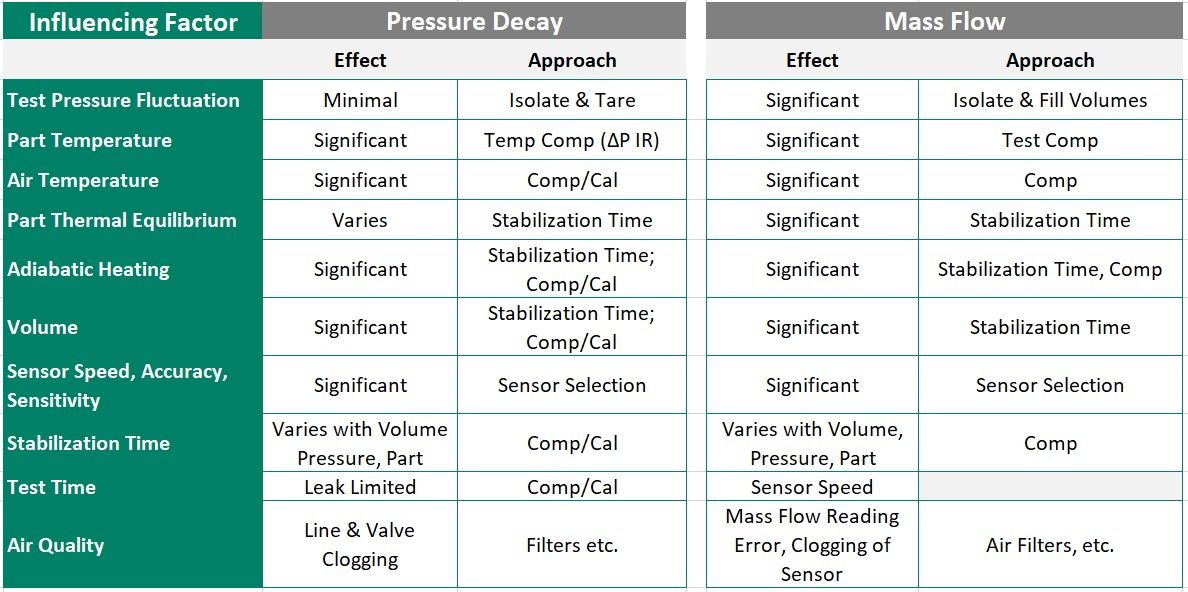Three Reasons To Ditch Dunk Testing
These are three reasons why you should stop dunk testing and consider pressure decay or mass flow leak testing for improved results.
As of late, there has been much discussion surrounding the differences between Mass Flow and Pressure Decay leak testing, specifically identifying when to use which test. While interviewing Uson’s leak test experts on the subject, their initial response was the same:
“It all depends on the application.”
Before we dive into why everything depends on the application to answer the question of which test to use when, let’s take a brief look at both test methods. Below is a great video demonstration of both test methods by Uson Applications Specialist, Steve Bencal, using our Sprint mD leak tester.
The Pressure Decay leak test is also known as gauge decay, absolute pressure, leak drop or delta pressure leak test. This test method measures the drop in pressure on a gauge (transducer) during the leak test. Pressure decay testing is used to test products for leaks by trapping pressure inside a product and then measuring pressure loss.
In this test method the component is pressurized with air and the pressure transducer monitors the pressure for negative changes. Any pressure drop indicates a leak. The pressure change from the first measurement to the last measurement made during the test phase of a test is what is important.
The test is very fast, a matter of seconds, and is therefore popular for leak testing in high-volume industries such as automotive components, castings, medical devices and consumer goods.
The mass flow test measures the amount of air passing through an object using units of measurement of sccm or liters/time period. The major advantage of the mass flow technique is that it eliminates the need to know the volume of the product. There are two mass flow sensing techniques that have found their way in to leak and flow testing: thermal mass flow and differential sensing mass flow.
Mass flow is a direct measurement of a leak or flow making it a preferred approach when you have a targeted flow specification for your part.
When establishing which of the two leak tests is the best choice for the application, our experts recommend starting with your objective. Do you, A) want to know IF your part has a leak? Or B) Do you want to know HOW MUCH your part leaks?
If you are looking for a leak, chances are that the part or component is NOT supposed to leak. A leak indicates that the part is faulty. An example of a part or component that’s not supposed to leak would be a catheter.
This scenario is for parts or components that are not sealed by design and intended to lack the ability to hold pressure. An example of a part that meets these criteria would be an engine block. The engine block is designed to allow oil, gas and air to flow in order for the engine to function.
Is there a GENERAL guide for when one test should be considered over the other? Our experts say “No” because, once again, everything is dependent on the individual application, and you can never REALLY answer the question confidently unless you do an Application Study. But, there are some VERY GENERAL factors that can help guide you to one test or another:

As shown in the table above, there are many factors that can influence results. Each factor presents its own distinct challenges in setting up cycle times and repeatability. Mass flow sensors detect pressure changes to calculate flow rate. In some cases, a certain amount of pressure drop is required in order for the sensor to indicate flow. Mass flow shines when used to determine if a part will flow to specification. For instance, looking at 1000 cc per minute to 20,000 cc per minute or up to 10 to 15 cubic feet per minute, these are cases where mass flow will excel over pressure decay.
Uson has had the privilege of working with hundreds of customers to perform application studies and develop leak specifications for thousands of parts. During our consultation process we see time and time again the concerns over test cycle times and how speed can impact the decision of which test and tester a customer chooses for their application. Why is speed a factor? The more parts you can test in less time equals more profit. Can this factor lead a customer down the wrong path? Absolutely. In rare cases where either a mass flow or a pressure decay test could be a viable option, 9 out of 10 times the customer will lean towards the option that offers the fastest cycle times and maximum throughput. In addition, pressure regulators are continually feeding mass flow which can cause flutter or variation in pressure that when detected by the mass flow sensor, can indicate that flow is occurring when it should not be, and therefore degrade repeatability and accuracy of that test. As experts, it’s our job to guide customers in evaluating the application study data and making an educated decision about which method(s) and tester is the best solution for their application. Based on all the data, and the objective, some compromise may be needed in order to implement the BEST solution as to which test is the more viable option.
Why is cost a consideration? A mass flow test requires a level of sensor sensitivity that is beyond what is available through standard supply channels. Building leak testers around the use of these sensors requires complex configurations and components, all of which are more costly than standard components. When you mix all of this together you get a piece of equipment that costs more to build and support. As mentioned earlier, the reality is that cost often influences the decision more than data. If the data indicates that mass flow is the right option for the application and will accomplish the testing objective, the budget should be calculated appropriately.
If you don’t know, or aren’t sure which test method is best for your application, Uson can help. Although your goals and objectives drive the path forward in test method selection, they are only one piece of the puzzle. And forgive the corny metaphor, but there are many pieces that make up the puzzle. Consulting with leak testing experts like Uson can shorten the evaluation and decision-making process, saving you hundreds in the short-term, and thousands, perhaps millions, in the long-term.
These are three reasons why you should stop dunk testing and consider pressure decay or mass flow leak testing for improved results.
Fuel pressure regulators plays a direct role in the distribution of fuel to the engine. There are several leak test method options to test this...
Uson has identified air leak testing as a viable option to helium leak testing in some EV Battery leak testing applications.
Industries
